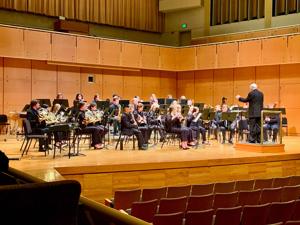Students, faculty and staff learned more about Illinois State University’s updated budgeting framework at the RISE Town Hall Forum.
The forum took place from 10-11 a.m. Thursday in the Prairie Room at the Bone Student Center.
Vice President for Academic Affairs and Provost Ani Yazedjian began by stating the purpose of this forum.
“This is the starting point, and then we have a lot of work to do moving forward,” Yazedjian said. “Our goal, really, is the financial success of [ISU].”
Yazedjian introduced Grant Thornton Managing Director Rick Strasser to the podium. He discussed the reasons for the budget redesign.
“An important thing that has changed this year is mining the budget directly,” Strasser said.
“I can say [that] in the past, that had not been the case here in the university. That is a recipe for spending your reserves in a way that is unsustainable at the university,” Strasser continued.
Additionally, campus stakeholders had little visibility into their operating results and relied on resolutions when budgets exceeded revenue.
Going forward, their mission is to build a resource allocation framework, deliver regular progress updates, build a model for multi-year financial planning, develop an allocation model to simplify decision making and collaborate using cross-functional teams in process and tool selection.
Vice President for Finance and Planning Glen Nelson elaborated on their budget model and approach.
“First, [our budget model] is going to be revenue-based. Our revenues define what we have available to spend,” Nelson said.
“Second, we would have an all-funds approach. In other words, we would be managing resources all across the university, not just separately from [auxiliary facilities services],” Nelson continued.
Nelson continued to explain the college-level budgeting plan to make strategic decisions at the university level.
“[We] want [our budgeting plan] to be performance-based so that there is an incentive for games, senior leadership, managers and anyone who is over a budget,” Nelson said.
Nelson said the budget model allocates revenues to align with enrollment by creating a concise dollar per student-credit-hour (SCH) and dollar per full-time equivalent (FTE).
According to Nelson, they will be “taking the pie that [they] have and cutting it into pieces.”
Additionally, the budget model will manage annual and rolling budget cycles, facilitate multi-year planning and empower colleges to manage resources as well as carry-forward balances.
Nelson then gave an explanation of the FY24 and the expenditure. He said that there is currently $225 million in net tuition, fees and state appropriations.
From this total, 58% is allocated to colleges and 42% is allocated to non-colleges.
“It’s identified what the dollar amount is, and then each of the vice presidents will look at their departments, identify what their increased costs are … and we will tell the traditional budget on that side of the university,” Nelson said.
Yazedjian elaborated on the potential risks of the budget redesign framework. These risks included a decline in enrollment and program cost imbalances.
“What we are doing with this process is identifying the single source of truth for the data that we are using … and saying for this budget model these are the data points you use, everybody’s gonna know and everybody will see it,” Yazedjian said.
Yazedjian stated their plan for success and the next steps they will be taking. They are going to finalize their budget model approach, develop revenue assumptions, release target dollars per SCH and FTE metrics and finalize the financial planning and analysis selection.
Nelson concluded the forum by reiterating the key takeaways.
“We’ve gone for simplicity versus precision. It’s designed to evolve … and a surplus has offset deficits, supporting constitutional resiliency,” Nelson said.
Additional information about the budget redesign framework can be found here.













